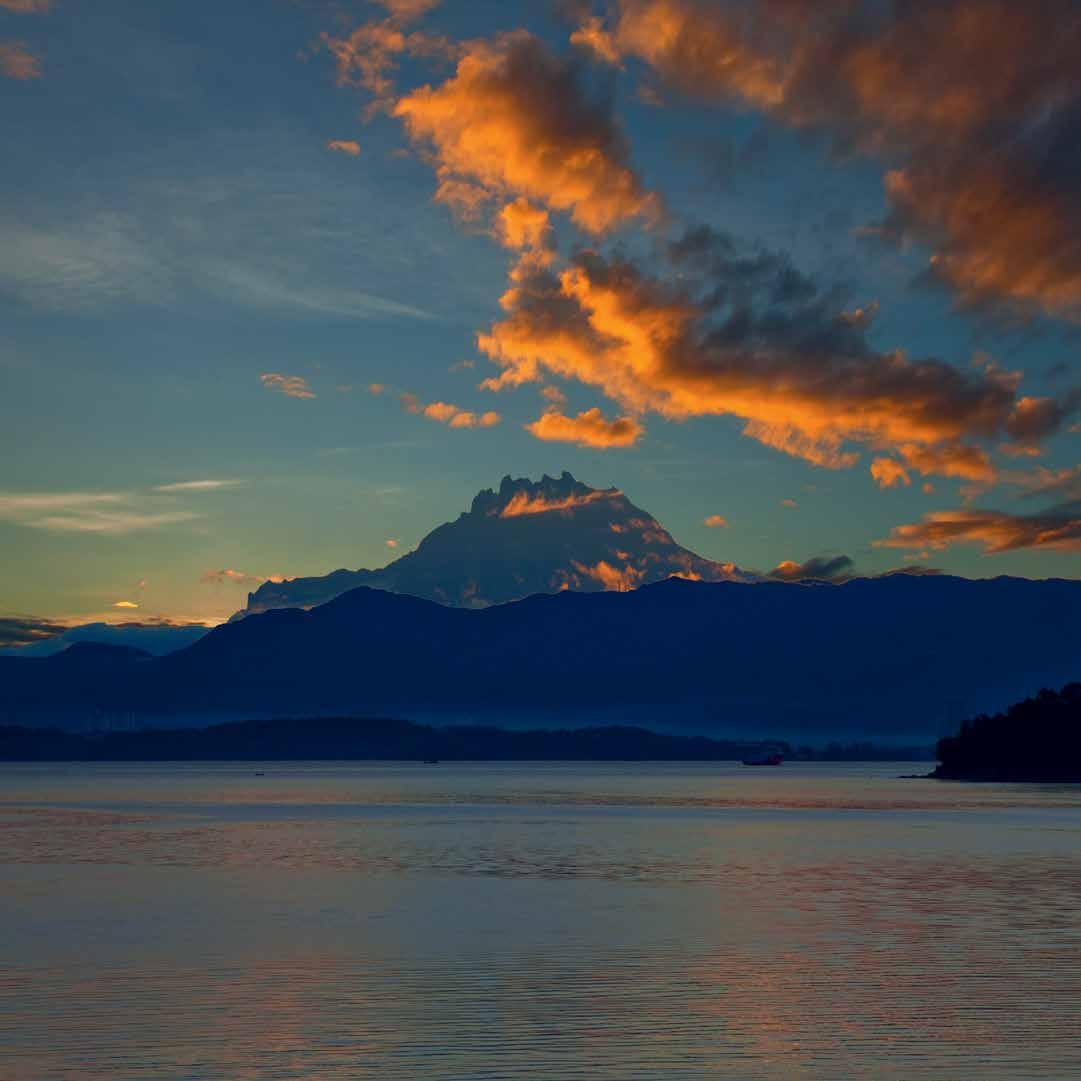
5 minute read
island of natural wonders
from YTL Life Fall 2022
by IMV Malaysia
This and facing pages: guests can discover the exceptional botanic reserve at Gaya Island Resort or explore the hidden wonders of the marine world, all under the guidance of the resort’s resident naturalist or marine biologist.
Words by KENNETH TAN
There’s something about Sabah that relaxes the world-weary traveller. Life here takes on an unhurried pace, perhaps a consequence of the solemn repose of Mount Kinabalu, the highest peak in Borneo rising 4,095m above the sea and visible from almost any vantage point in Kota Kinabalu. This sense of certainty is a rhythmic beat that calms the soul.
That ineffable feeling that all will be well becomes even more pronounced as you step onto the speedboat at Jesselton Point in Kota Kinabalu and, within 10 minutes, arrive at the idyllic paradise of Gaya Island Resort – a five-star property and member of the Small Luxury Hotels. Located in the heart of Tunku Abdul Rahman Marine Park, Gaya Island is largely gazetted as a national park, which protects and preserves its unique, native populations of flora and fauna.
Upon leaving the pier, guests fall into a lull of the jungle’s soothing rhythms, with the morning warbling of birdsong, afternoon riffs from mangrove cicadas and an evening serenade of wildlife from the rainforest canopy. All around the resort, a sense of theatre pervades; a monitor lizard doing languid laps in the stream, its speckled band flecked by sunlight, while a long-tailed macaque grooms her youngling as it impatiently waits to rejoin its monkey friends at play. Up overhead, a white-bellied sea eagle soars towards its treetop eyrie, with its white breast indicating its relative youthfulness (adults develop brown patches).
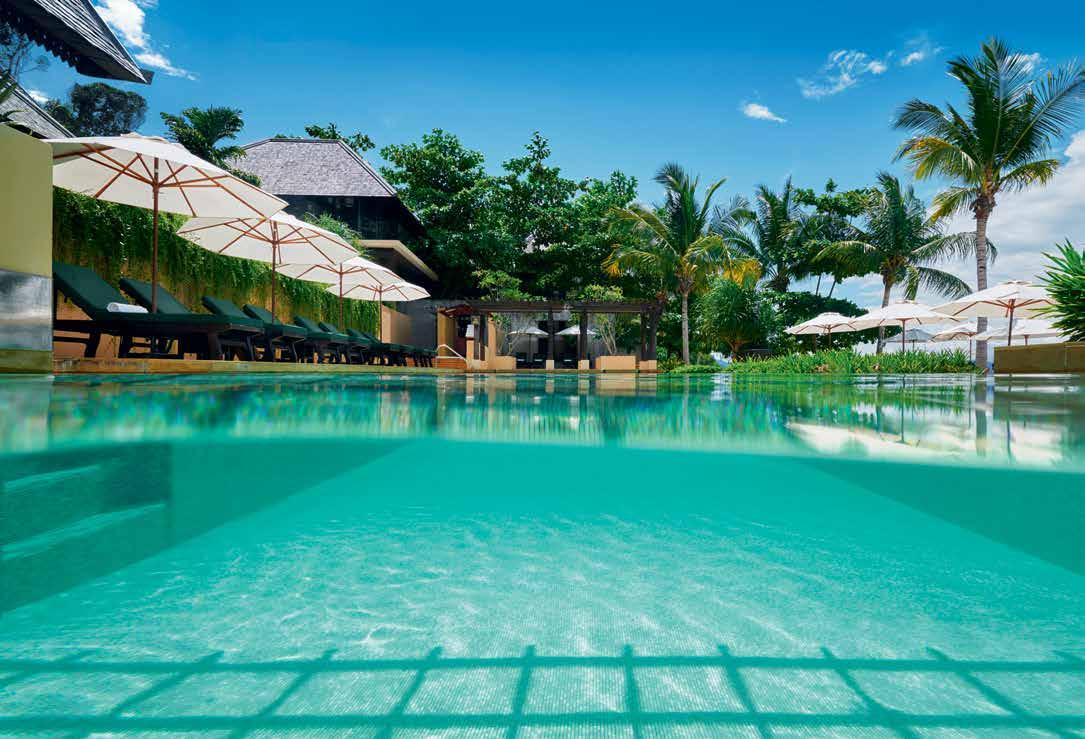
At the nearby mangrove forests, where the resort’s senior naturalist, Justin Juhun, leads morning kayak tours, one is likely to spot great egrets, horseshoe crabs and even an oriental pied hornbill. The experience is almost surreal, with the journey taking guests through a natural amphitheatre carved out by running streams and time. The air is cooler and richer as mangroves are 10 times more effective in recycling carbon and producing oxygen versus the rainforest.
Juhun, whose conservation work at Gaya Island Resort was recognised with a platinum award for CSR leadership at the 2018 Global CSR Summit and Awards, is a true-blue Sabahan, growing up in Tawau with a father who had plenty of animal lore. Graduating with a degree in hotel management, Juhun then set out on his naturalist path: undertaking orangutan conservation, wetlands management and training in the UK before returning to Sabah to serve at Gaya Island Resort. He describes his office as a “treasure island” due to its breakaway from Borneo, thus leading to its unique gene pools and evolutionary results. “No other island in Sabah has proboscis monkeys. It is one of the seven wonders of Gaya Island, which also includes the mangrove forests, red giant flying squirrels, bearded pigs, fireflies, elephant foot yam and the boobook owl.”
This and facing pages: this beachfront resort blends harmoniously with the natural environment and features a collection of hillside villas with views that range from mangrove forests and the surrounding canopy to the outline of Mount Kinabalu.
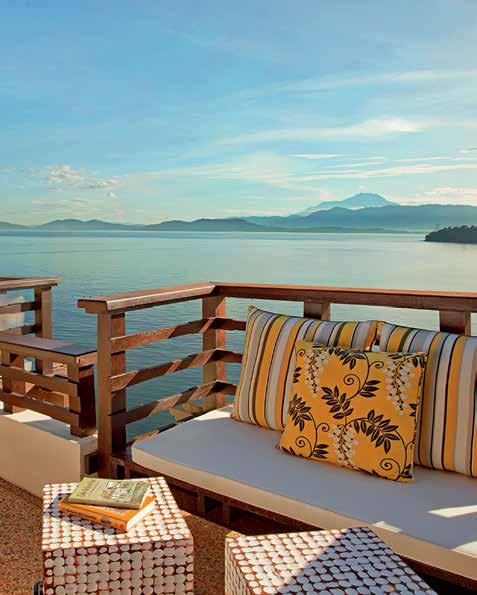

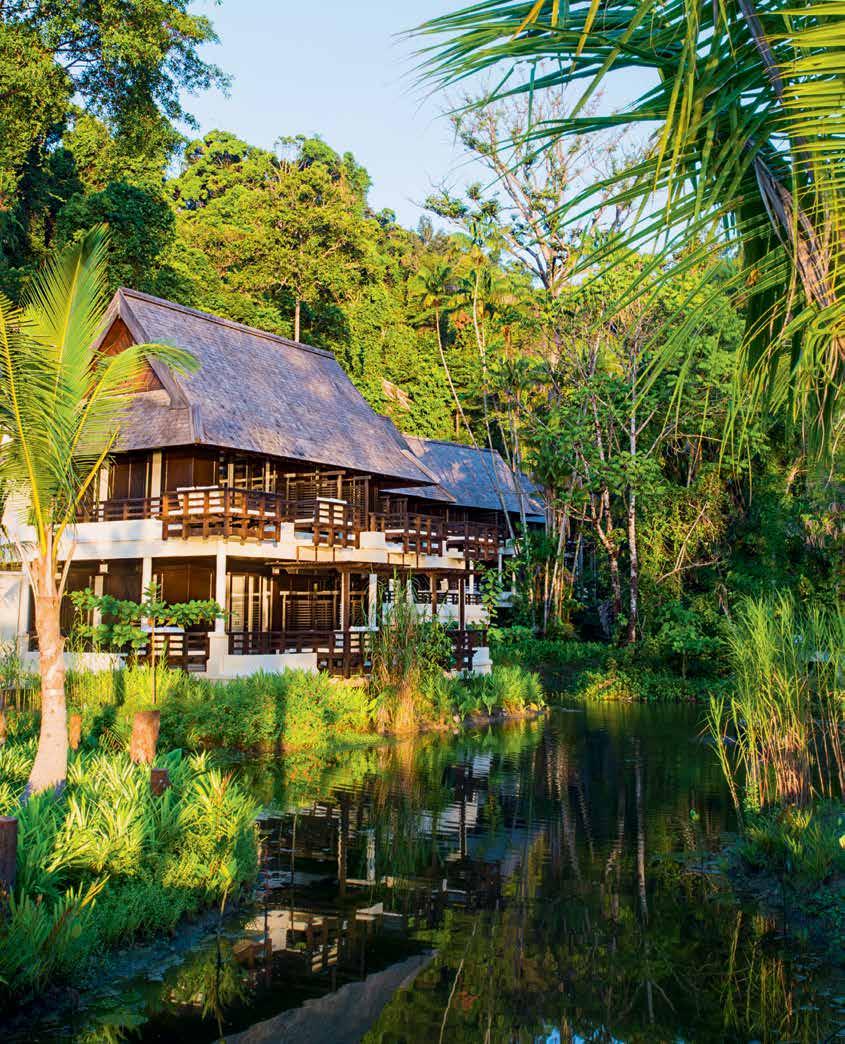
THE RESORT’S OPTIONS OF VILLAS, BAYU, CANOPY AND KINABALU, ARE CAPACIOUS AND OFFER WARM, WOODY INTERIORS TO KEEP THAT CONNECTION TO THE OUTDOORS.
This page, clockwise from top: proboscis monkeys; villas overlooking the South China Sea; great egrets; marine biodiversity; resident naturalist, Justin Juhun.
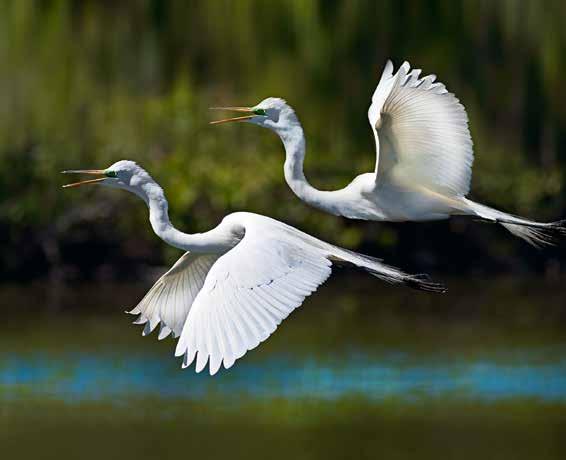

Facing page: a rich tapestry of spa programmes at Spa Village reflects the cultural healing traditions of Sabah’s indigenous people.
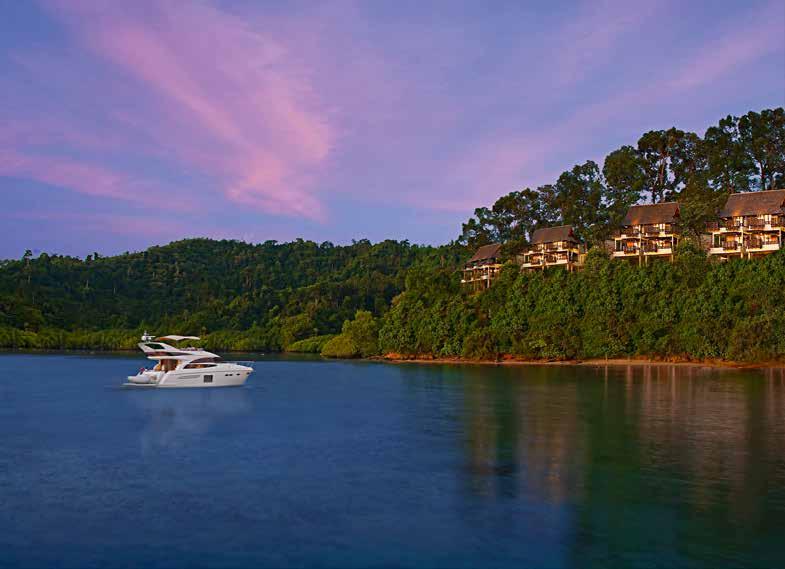
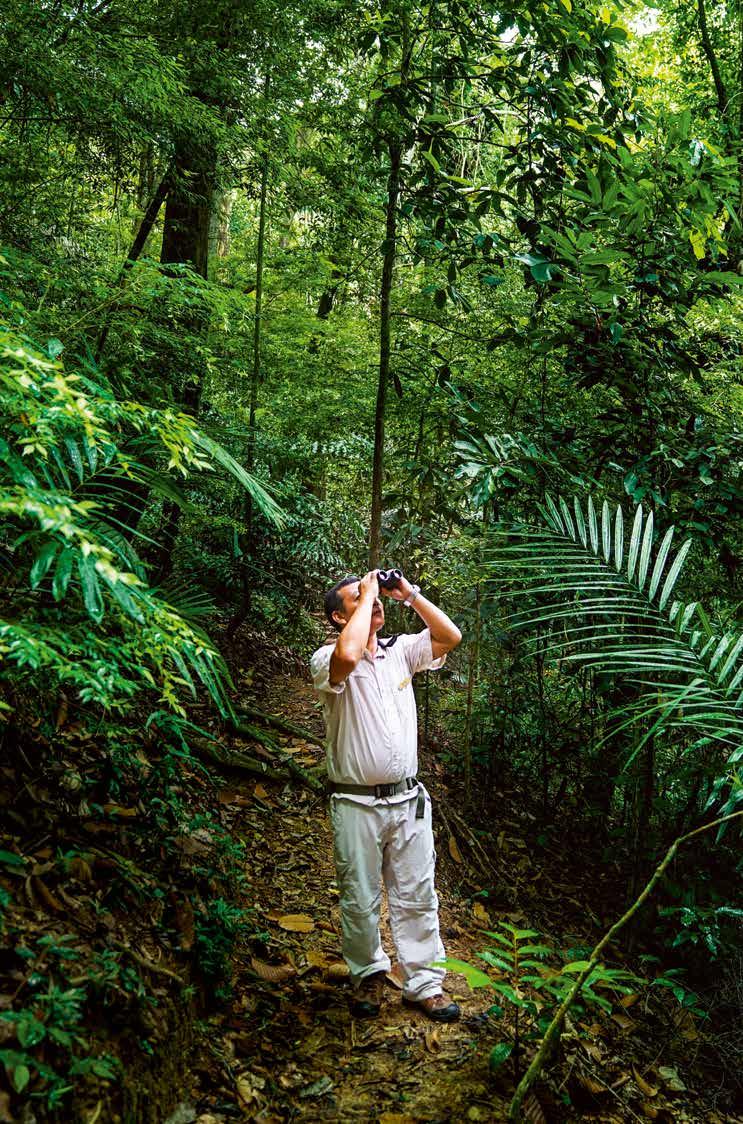
Juhun also leads the morning nature walks which take guests deep into the mother forest of Gaya Island, where the shy and endangered proboscis monkeys are occasionally spotted. The trail wends its way through towering hardwood trees and a diversity of flora, from strangler figs and elongated rattan to vermillion-coloured fungi.
Back at the resort, hourly boat transfers to Tavajun Bay – a tranquil strip of beach further out – reveal the Gaya Island Resort Marine Centre helmed by the resort’s marine biologist Scott Mayback, who specialises in coral restoration and turtle rescue. Over the past six years since the centre’s establishment, Mayback and his team have overseen 20 individual turtle rescues and undertaken the planting of over 1,200 coral slabs on the seabed.
The coral planting which Mayback conducts starts with a guided snorkelling exploration for guests, who will then emerge from the waters with bits of coral that will become the foundation of new reefs. These fragments – which grow at a pace of two centimetres per year – are attached to a concrete slab to encourage greater multiplication of the reefs over time – one of the most important breeding habitats for fish, providing refuge for over 25 per cent of all marine life. The crystal clear waters of Gaya Island are conducive to the growth of corals, and Mayback is also experimenting with micro-fragmentation of corals to accelerate reproduction rates up to 47 times to re-establish reefs around the island.
At one end of the resort, the Spa Village, enrobed by the rainforest’s greenery, is a great way to unwind – with massages and natural therapies designed to soothe and relax. And because time seems to become elongated at Gaya Island Resort, ladies may opt for the Unduk Ngadau treatment, named after the Kadazandusun beauty pageant held at the end of the harvest festival in Sabah annually. It is an indulgent three-hour session comprising a body scrub, hair mask, indigenous massage and a facial.
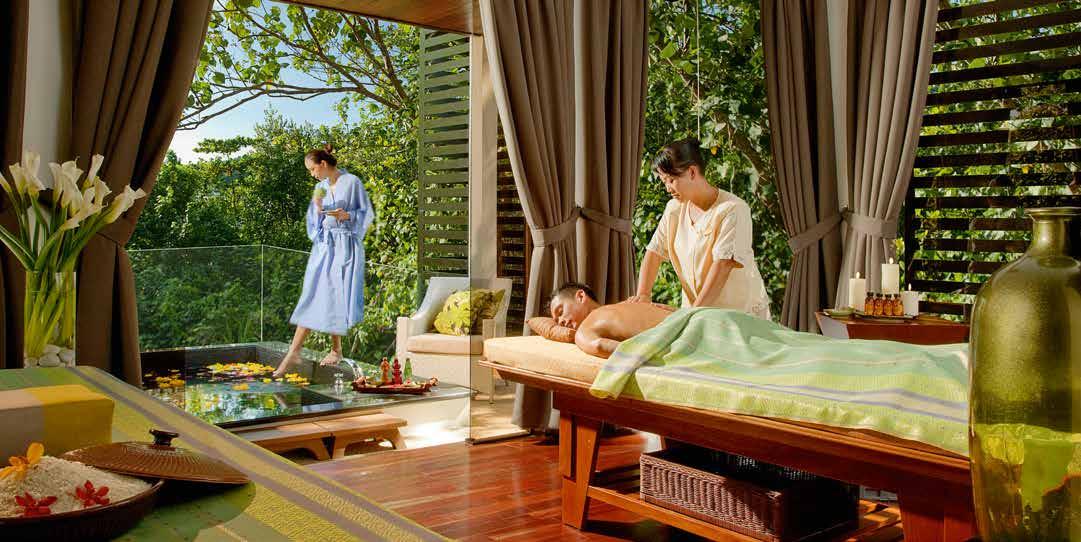
As with every Spa Village within the YTH Hotels fraternity, each centre offers one-of-a-kind regimens inspired by the healing culture of its location using fresh local ingredients. The result, in the case of the Gaya Island Resort spa iteration, is an authentic treatment that marries age-old traditions –such as the rice scrubs and masks of the Kadazandusun and the age-old practices of the Bajau sea nomads – with modern approaches to rejuvenate body and soul.
The resort’s options of villas, Bayu, Canopy and Kinabalu, are capacious and offer warm, woody interiors to keep that connection to the outdoors. The two-bedroom Suria Suite is perched on the hillside and spans over 188sqm, with fulllength windows and balconies that open up to vistas of the South China Sea. And, of course, for the in-between moments, there’s always the plethora of dining options at the resort ranging from its Feast Village which offers a perfectly grilled tuna steak with hints of pepper and salt to the Japanese-styled Omakase which has a chef’s table and serves nabeyaki and shabu-shabu under the evening sky.
Couples will love the dreamy candlelit dinners with the exquisite seafood at Fisherman’s Cove as they dine to the lullaby of lapping waves, while Tavajun Bay caters to bigger groups of families and friends with a barbecue lunch. At the main resort’s pool bar and lounge, lazy afternoons are complemented by the bossa nova sounds of a different kind of warbler – perchance a chanteuse like Cecilia Dale – and a choice of international and local favourites, from pizzas and tuna tataki to curry laksa and banana fritters, paired with a deliciously cold glass of wine.
For more information, visit www.gayaislandresort.com
This page: professionally trained butlers manage your stay from wake-up to lights-out.










